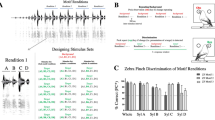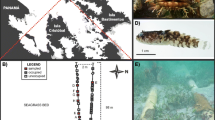Abstract
Oilbirds, Steatornis caripensis, live in colonies in caves, within which they navigate by echolocation (Griffin 1953, Snow 1961). The sonar “clicks” of these nocturnal birds typically last about 40 to 80 ms and are emitted at repetition rates up to about 12/s. Most of the acoustic energy lies beween 1 and 15 kHz. Sound during some clicks is continuous but other clicks, here referred to as double clicks, are divided by a silent period lasting about 20–30 ms into two brief bursts of sound.
Access this chapter
Tax calculation will be finalised at checkout
Purchases are for personal use only
Preview
Unable to display preview. Download preview PDF.
Similar content being viewed by others
References
Griffin, D. R. 1953. Acoustic orientation in the oilbird, Steatornis. Proc. Natl. Acad. Sci. U.S.A. 39: 884.
Roederer, J. G. 1974. “Introduction to the Physics and Psychophysics of Music.” Springer Verlag, New York.
Snow, D. W. 1961. The natural history of the oilbird, Steatornis caripensis, in Trinidad W. I. I. General behavior and breeding habits. Zoologica 46: 27.
Suthers, R. A. 1986. Avian vocal tract resonance: Structural variation produces individually unique vocalizations in oilbirds. Submitted for publication.
Suthers, R. A. and Hector, D. H. 1985. The physiology of vocalization by the echolocating oilbird, Steatornis caripensis. J. Comp. Physiol. A 156: 243.
Author information
Authors and Affiliations
Editor information
Editors and Affiliations
Rights and permissions
Copyright information
© 1988 Plenum Press, New York
About this chapter
Cite this chapter
Suthers, R.A., Hector, D.H. (1988). Individual Variation in Vocal Tract Resonance May Assist Oilbirds in Recognizing Echoes of Their Own Sonar Clicks. In: Nachtigall, P.E., Moore, P.W.B. (eds) Animal Sonar. NATO ASI Science, vol 156. Springer, Boston, MA. https://doi.org/10.1007/978-1-4684-7493-0_9
Download citation
DOI: https://doi.org/10.1007/978-1-4684-7493-0_9
Publisher Name: Springer, Boston, MA
Print ISBN: 978-1-4684-7495-4
Online ISBN: 978-1-4684-7493-0
eBook Packages: Springer Book Archive




